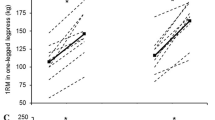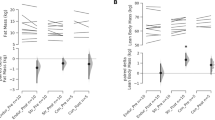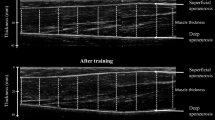Summary
Muscular strength and fatigability of strength-trained (ST) and untrained (UT) women were compared during a 6-min bout of maximal rhythmic exercise involving the elbow flexor muscles given at a rate of 30 contractions · min−1. Fifteen ST and 15 UT subjects, aged 18–34 years and pair-matched for body size, were tested for differences in initial strength, final strength, absolute endurance, relative endurance, and rate of fatigue. Results revealed a significant difference in initial strength, final strength, and absolute endurance in favor of ST subjects. No significant difference was found for relative endurance, and rates of fatigue were similar for both groups. It is concluded that muscular strength and endurance are enhanced in women engaged in a training program designed primarily to increase muscular strength and hypertrophy, but fatigability is not affected.
Similar content being viewed by others
References
Clarke DH (1971) The influence on muscular fatigue patterns of the intercontraction rest interval. Med Sci Sports 3:83–88
Clarke DH (1985) Alterations in fatigue patterns as a function of intercontraction rest in human handgrip muscles. In: Dotson CO, Humphrey JM (eds) Current selected research in exercise physiology, vol 1. AMS Press, New York, pp 117–127
Clarke DH (1986) Sex differences in strength and fatigability. Res Q Exerc Sport 57:144–149
Clarke DH, Stull GA (1970) Endurance training as a determinant of strength and fatigability. Res Q 41:19–26
Cureton KJ, Collins MA, Hill DW, McElhannon JR (1988) Muscle hypertrophy in men and women. Med Sci Sports Exerc 20:338–344
DeLorme T, Watkins A (1948) Technics of progressive resistance exercise. Arch Phys Med Rehabil 29:263–273
Dudley GA, Djamil R (1985) Incompatibility of endurance- and strength-training modes of exercise. J Appl Physiol 59:1446–1451
Edwards RHT, Gibson H (1991) Perspectives in the study of normal and pathological skeletal muscle. In: Atlan G, Beliveau L, Bouissou P (eds) Muscle fatigue: biochemical and physiological aspects. Masson, Paris, pp 3–15
Gollnick PD, Timson BF, Moore RL, Riedy M (1981) Muscular enlargement and number of fibers in skeletal muscles of rats. J Appl Physiol 40:936–943
Heyward V, McCreary L (1977) Analysis of the static strength and relative endurance of women athletes. Res Q Exerc Sport 48:703–710
Hickson RC (1980) Interference of strength development by simultaneously training for strength and endurance. Eur J Appl Physiol 45:255–263
Kroll W (1971) Isometric strength fatigue patterns in female subjects. Res Q 42:286–298
Montoye HJ, Lamphiear DE (1977) Grip and arm strength in males and females, age 10 to 69. Res Q 48:109–120
Ordway GA, Kearney JT, Stull GA (1977) Rhythmic isometric fatigue patterns of the elbow flexors and knee extensors. Res Q 48:734–740
Staron RS, Hikida RS, Hagerman FC, Dudley GA, Murray TF (1984) Human skeletal muscle fiber type adaptability to various workloads. J Histochem Cytochem 32:146–152
Staron RS, Malicky ES, Leonardi MJ, Falkel JE, Hagerman FC, Dudley GA (1990) Muscle hypertrophy and fast fiber type conversions in heavy resistance-trained women. Eur J Appl Physiol 60:71–79
Staron RS, Leonardi MJ, Karapondo DL, Malicky ES, Falkel JE, Hagerman FC, Hikida RS (1991) Strength and skeletal muscle adaptations in heavy-resistance-trained women. J Appl Physiol 70:631–640
Stull GA, Clarke DH (1970) High-resistance, low-repetition training as a determiner of strength and fatigability. Res Q 41:189–193
Thorstensson A, Hulten B, Dobeln W von, Karlsson J (1976) Effect of strength training on enzyme activities and fibre characteristics in human skeletal muscle. Acta Physiol Scand 96:392–398
Wilmore JH (1974) Alterations in strength, body composition, and anthropometric measurements consequent to a 10-week weight training program. Med Sci Sport 6:133–138
Author information
Authors and Affiliations
Rights and permissions
About this article
Cite this article
Huczel, H.A., Clarke, D.H. A comparison of strength and muscle endurance in strength-trained and untrained women. Europ. J. Appl. Physiol. 64, 467–470 (1992). https://doi.org/10.1007/BF00625069
Accepted:
Issue Date:
DOI: https://doi.org/10.1007/BF00625069




